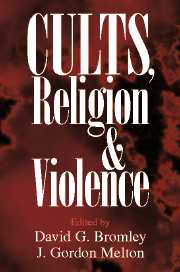Book contents
- Frontmatter
- Contents
- Acknowledgments
- Contributors
- Prologue
- 1 Violence and Religion in Perspective
- 2 Dramatic Denouements
- 3 Challenging Misconceptions about the New Religions–Violence Connection
- 4 Sources of Volatility in Religious Movements
- 5 Crises of Charismatic Legitimacy and Violent Behavior in New Religious Movements
- 6 Public Agency Involvement in Government–Religious Movement Confrontations
- 7 Watching for Violence: A Comparative Analysis of the Roles of Five Types of Cult-Watching Groups
- 8 Mass Suicide and the Branch Davidians
- 9 Occult Masters and the Temple of Doom: The Fiery End of the Solar Temple
- 10 Dramatic Confrontations: Aum Shinrikyô against the World
- 11 Making Sense of the Heaven's Gate Suicides
- 12 Lessons from the Past, Perspective for the Future
- Index
- References
12 - Lessons from the Past, Perspective for the Future
Published online by Cambridge University Press: 09 July 2009
- Frontmatter
- Contents
- Acknowledgments
- Contributors
- Prologue
- 1 Violence and Religion in Perspective
- 2 Dramatic Denouements
- 3 Challenging Misconceptions about the New Religions–Violence Connection
- 4 Sources of Volatility in Religious Movements
- 5 Crises of Charismatic Legitimacy and Violent Behavior in New Religious Movements
- 6 Public Agency Involvement in Government–Religious Movement Confrontations
- 7 Watching for Violence: A Comparative Analysis of the Roles of Five Types of Cult-Watching Groups
- 8 Mass Suicide and the Branch Davidians
- 9 Occult Masters and the Temple of Doom: The Fiery End of the Solar Temple
- 10 Dramatic Confrontations: Aum Shinrikyô against the World
- 11 Making Sense of the Heaven's Gate Suicides
- 12 Lessons from the Past, Perspective for the Future
- Index
- References
Summary
Dramatic Denouements involving new religious movements have become the focus of a surge of scholarly attention over the last decade. For a time after the occurrence of the Peoples Temple episode, there was a tendency to treat scattered violent incidents idiosyncratically, as few historical counterparts had been studied by social scientists. The occurrence of several high-profile episodes over the last decade created the impetus and opportunity to develop a more general understanding of these Dramatic Denouements. In order to achieve greater theoretical specification, we have deliberately limited the focus in this volume to a small set of events that have key elements in common rather than theorize broadly about the complex, multifaceted relationship between religion and violence. The dynamics of conflict between control agencies and governmentally sponsored guerrilla groups, for example, might well differ in some important ways from the events analyzed here. In this concluding chapter we consider three important issues: the likelihood of future violent incidents, the sociopolitical context within which such incidents are likely to occur, and the perspective gained from analyzing recent cases that might be brought to bear on any future episodes.
Future Episodes
There are a number of reasons to anticipate future incidents that resemble in some measure the episodes analyzed in this volume. At the most fundamental level, this expectation is based on the observation that the histories of the major religious traditions are replete with the creation of both unity and division, harmony and conflict.
- Type
- Chapter
- Information
- Cults, Religion, and Violence , pp. 229 - 244Publisher: Cambridge University PressPrint publication year: 2002
References
- 1
- Cited by

